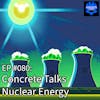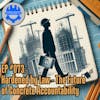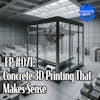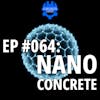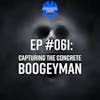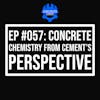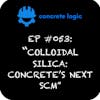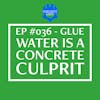EP #077: Concrete Tension - The Strength of Post-Tensioning
In this episode, Seth interviews Neel Khosa from AMSYSCO, a post-tensioning supplier, to introduce post-tensioning and its history. Post-tensioning is a form of concrete reinforcement that uses high-strength steel cables inside concrete. It is about five times stronger than conventional rebar and is used in pre-stressed concrete.
Unbonded post-tensioning is the standard for high-rise construction and large concrete structures in the US. The advantages of post-tensioning include material savings, reduced construction time, improved seismic behavior, and reduced deflections and vibrations. The future of post-tensioning includes its use in office buildings and the development of new systems.
Takeaways
- Post-tensioning is a form of concrete reinforcement that uses high-strength steel cables inside concrete.
- Unbonded post-tensioning is the standard for high-rise construction and large concrete structures in the US.
- Post-tensioning offers material savings, reduced construction time, improved seismic behavior, and reduced deflections and vibrations.
- The future of post-tensioning includes its use in office buildings and the development of new systems.
Chapters
00:00 Introduction to Post-Tensioning
03:32 History of Post-Tensioning
05:09 Unbonded Post-Tensioning
11:21 Importance of Visual Representation of Post-Tensioning
12:17 Advantages of Post-Tensioning
16:15 Basic Engineering of Post-Tensioning
18:25 Fundamental Description of Post-Tensioning
20:37 Stressing Ends and Pulling Cables
23:19 Origin of Post-Tensioning
25:23 Post-Tensioning in High-Rise Buildings
30:01 Future Developments in Post-Tensioning
35:24 Conclusion and Contact Information
***
Did you learn something from this episode? If so, please consider donating to the show to help us continue to provide high-quality content for the concrete industry.
Donate here: https://www.concretelogicpodcast.com/support/
***
Episode References
Guest: Neel Khosa | AMSYSCO | nkhosa@amsyscoinc.com
Guest Website: https://amsyscoinc.com
Producers: Jodi Tandett, Jace Stocker
Donate & Become a Producer: https://www.concretelogicpodcast.com/support/
Music: Mike Dunton | https://www.mikeduntonmusic.com | mikeduntonmusic@gmail.com | Instagram @Mike_Dunton
Host: Seth Tandett, seth@concretelogicpodcast.com
Host LinkedIn: https://www.linkedin.com/in/seth-tandett/
Website: https://www.concretelogicpodcast.com/
LinkedIn: https://www.linkedin.com/company/concrete-logic-podcast
[00:00:00] Seth: Welcome to another episode of the Concrete Logic Podcast, and today I have Neel Khosa with me from AMSYSCO, a post-tensioning supplier. So Neel's going to give us the this is the first time we've done a post-tensioning. Podcast episode, so Neel's going to help us by giving us an introduction to what post-tensioning is and a little history about post tensioning before we get started, like I do for folks that listen to the show you, you've heard me say this over the last, I don't know, half a dozen or a dozen episodes now, but just how this podcast works and how you can support the podcast is.
Go to ConcreteLogicPodcast.com, and if you get some value out of this show, please share the, whatever episode that you think a colleague or a coworker would enjoy. So, we are coming close to, I think, when this podcast Is released. We're going to be around 77 or 78 episodes. So there's plenty for you all to check out.
So go to concrete logic, podcast. com, and then you go to episode that click on the episodes button and you can see all the episodes. So that's the first way to share, share the podcast with them. A colleague or a coworker. The second way you can support the show is on the website. Again, in the bottom right hand corner, there's a microphone button.
If you click on that microphone button, you can leave me a voicemail or a message. And what I'm looking for from you on that is some feedback on the show. If you enjoy the show or you can give me a topic suggestion or a guest suggestion. So most of the guests that I have on the show is a suggestion from a listener.
So that you get this show is for you all. So if there's somebody that you want to hear from or a topic you want to hear about, please let me know. And then the third way. That you can support the show again. If you get some kind of value at, out of the show, you learn something from my discussion with Neel today or any of the other podcast episodes, there's a donate button on the homepage on concretelogicpodcast.com. You click on that donate button and you can give any amount and any amount is really appreciated. So don't worry about what the amount is. It's what you get out of this podcast. So if you think it's worth a dollar. Great. I'll take your dollar and it helps the show. Keep the lights on.
And when you do donate to the show, the next podcast episode that I release, you'll be listed as a producer of the show. So if you guys whatever platform you listen to and you go to the show notes and you scroll down. You'll see the guest information, how to get a hold of the guest. And then right below that are producers of the show.
Those are people that are donating to the show. So that's what that is. So, but anyways, now that I explained all that, Neel, let's get let's get started on an introduction to what post tensioning is. So could you kick us
[00:03:13] Neel Khosa: off? Yeah, for sure. I was going to actually defer to you since you've already had experience in your previous life with post tensioning, so you could probably talk a little bit about it.
But yeah, in general, post tensioning is a form of concrete reinforcement. So it's when I talk to my friends who know nothing about construction or concrete, they say, Oh, it's like rebar. And I say, yeah, it's a little different though. It's more specialized and niche. It's five times stronger than conventional rebar.
But for construction people it's a form of pre stressed concrete. So it's a cousin of precast concrete. Both of those use high strength steel cable that's inside a concrete. The main difference with post tensioning versus precast is you pour the concrete after or sorry, you pour the concrete and then you stress the cables after the concrete's poured and reaches strength.
So, that's the high level version of post tensioning. I can dive into the history of it, but specifically my expertise is with unbonded post tensioning. There's different forms of post tensioning. There's bonded PT that's used mainly in bridges in the U. S. But other foreign countries use bonded PT in buildings as well.
There's also PT bars that's usually used in Geotech. But unbonded PT is, I'd say, the standard for high rise construction and large concrete structures in the U. S. for mainly in the floors. Although there are sometimes, there are some special applications.
[00:04:44] Seth: Yeah, so I was gonna look up some images.
Maybe we can share those. But anyways, so the, so everyone understands what Neel's talking about and what I have experienced with this, the unbonded post tensioning system, which is OK. Essentially a cab there, these cables, and I was gonna pull this up actually so people that are, if you're watching on YouTube can see this but they look like cables.
And,
[00:05:14] Neel Khosa: yeah, the strand is basically seven wires that are braided together, like hair, and then there's a thin layer of PT coating, which we affectionately call grease, and what that does is, it basically provides corrosion. Protection and it provides lubrication outside of that layer is an extruded plastic sheathing and that is what prevents the strand from bonding to the concrete.
Yep. Yeah. There you go.
[00:05:43] Seth: There you go, and they really augmented the strands on that one, didn't they?
[00:05:48] Neel Khosa: Yeah, so that's bonded, I think, with those spirals, and then Yeah,
[00:05:52] Seth: so what about this one, right? That's a little small.
[00:05:56] Neel Khosa: Let me see if I can Yeah, there you go. So yeah, that's unbonded PT in a nutshell, and that's,
[00:06:01] Seth: Yeah, so it's in that plastic sleeve, right?
[00:06:05] Neel Khosa: Correct, correct. So when you tension the cable after the concrete's poured, that's what's providing the force to the structure. So generally, we're shooting for around 27 kips. One kip is 1, 000 pounds, so it's pretty high strength. So you're getting just from one cable, you've got 27, 000 pounds of force.
And obviously you've got Hundreds if not thousands and one concrete pour.
[00:06:32] Seth: Right. And then, yeah, there's all you Google this stuff. You sit here and look at pictures all day long.
[00:06:39] Neel Khosa: Oh, yeah, I think that's actually from one of our websites. The green.
[00:06:44] Seth: Yeah, I went to so, the, the concrete guys, well, so everybody knows what ACI is, and then post tensioning group, the guys use PTI, right? That's the main group that, yeah.
[00:06:59] Neel Khosa: Yeah, PTI actually used to be part of PCI, and then it stood off in the late 70s. And actually, ACI is affiliated with PTI just because ACI's got the code and PTI has more of a specification.
And there's also obviously a loose connection to IBC for international building code. So, but yeah, all of that is the governing bodies for how PT is made. So it's a manufactured product rather than assembled.
[00:07:28] Seth: And the other reason well, the reason I brought them up is when we started a discussion, I brought up PTI's website and I was like, they need more pictures.
They need more pictures. Like you do this for, a living. So you know what these things look like at, cause you look at them every day and then concrete. Contractors, they, that do multi-level structural frame concrete frame work. They probably know what this stuff is, but if you want to get, if you want to get folks that are, in younger folks that are coming through like the, engineering program or a concrete industry management program.
Those folks, I think that's what these like PTI and ACI and those groups, they need to realize that, Hey, we could, you can Google this stuff and look it up, but it would really help be helpful on those websites that they had more pictures that you can get to without paying for,
[00:08:27] Neel Khosa: well, I would refer you to the AMSYSCO blog. I used the blog way back when, in the, I'd say mid-2000s, and it's got plenty of references and articles and pictures and videos even. Oh, well let's pull that up. So, you could actually just click on that AMSYSCO De-tensioning, and I'm sure it'll go to something.
Hey, there's your dad.
Yeah, my dad's been in the PT industry for probably 50 years at this point. He started after graduating from University of Maryland and then worked. First job out of masters was in a PT company, which he knew nothing about and then worked basically a decade and decided to start his own business, which I was a baby at the time.
So AMSYSCO is like my little brother it was always there growing up and I worked grade schools and high school, college summers, just learning about the business, obviously as a kid, and then worked actually for a GC out of college. I went to university of Illinois, got my bachelor's there in civil.
But then came back home to AMSYSCO and basically been here for 20 years. It feels like 40 is.
[00:09:46] Seth: Yeah. No, I think you all were I was sharing what is, I think you all were on my first. Well, my first my very first job when I started my concrete career was a post tension job. It's a post tension parking garage done a lot of parking garages, but yeah, so I've known AMSYSCO for a long time just hadn't really.
Kept in touch with you since I moved to Virginia 20 years ago because y'all don't do work down here. I think I've reached out to you before. I say hey, Neel, can you send me PT down here? And you're like, ah, we don't go that far. But yeah, so let's get back on top on the topic. So I think we're I'm just flipping through some pictures here.
So if you're watching on YouTube, you get an idea of what this stuff looks like. But yeah, like, Neel was sharing that there's these strands inside a plastic sleeve. And then I guess the 1 of the best explanations of. Of PT I've heard in the past is, so you lay the, these cables down across the slab and then you also have these cables in a beam.
And the purpose of the using PT is that you can reduce the amount of rebar as well. That's, and also most of the time you can also make the thickness of the slab itself thinner. Is that a correct statement?
[00:11:08] Neel Khosa: Yeah, so for, I'd say parking structures usually see a beam and slab system, although sometimes you see a flat plate system.
So there's no beams. It's a uniform slab thickness. But for skyscrapers, it's, I would say, 9 times out of 9, or 10 times out of 10. It's always flat construction, so compared to, I'll start with structural steel. You've got X amount of floor to floor height, and then for a conventional concrete, no PT it's smaller, but for PT, it's even smaller than that.
So, let's just hypothetically say you've got a 10 inch rebar slab with PT, you could probably do it in 8 inches, so that 2 inches, if you multiply it by 50 stories, it adds up, and you've got 50 inches times 2, so 100 inches for that whole building. That building gets lighter so your dead load is less, your foundations can be shrunk a little bit.
All your vertical elements get shrunk as well. So think about anything that's vertical. You got your facade, your piping that goes up and down your stairs, your all your columns obviously your floor height as well. So that reduces the material savings, which ultimately no one would use PT if it didn't save money.
Let's be candid. Dollars talk. Another benefit that PT has is it doesn't take any longer to build a PT structure than a normal building, and sometimes it's even quicker. So, traditionally in Chicago we're doing, for skyscrapers, one floor every two or three days, sometimes, four days.
So that construction cycle also ends up being a dollar savings to the owner if they can open a building quicker. And in seismic areas, which we're not, we're based in Chicago, but we do work, I'd say, semi nationwide. But if you're out in California, where there's seismic activity, that PT actually helps with seismic behavior of the building.
Back to parking structures compared to like a precast parking structure post tension parking structure. It'll help reduce deflections and vibrations, and you won't, you don't have all those joints that you need to maintain, so your waterproofing and your crack controls improved using PT.
So, theoretically, your life cycle costs, and I don't want to get too controversial with life cycle, because I think everyone's got an aversion to saying something's green when maybe it's not green, and you might get caught. I'm saying something that may not be true in the long run, but in theory, if you're building height is less than theoretically, you're using less energy to pump water to the 70th floor or things like that.
[00:13:57] Seth: You could slice and dice depending on what building material you're talking about and make it look good or terrible. I think.
[00:14:05] Neel Khosa: Yeah. Yeah. And the big negative with PT is it does have a carbon footprint just because it's high carbon steel. So we can't avoid talking about some of the downsides with any material.
You've got to present both sides of it to have a fair and balanced discussion.
[00:14:22] Seth: Anything that's manufactured has a carbon footprint cause you need energy to manufacture it. So, but yeah. And then to explain, basic, I would call it. Basic engineering, Neel, of PT, so you're laying these cables, and you lay them across the formwork, and they sit on these chairs, right?
And then they have a profile, they go up, Curve up and down, right? And then so you got these cables that are laid out and then you pour the concrete, you poured a slab before, the, whatever slab beams, all that stuff, you pour that. And then the concrete's got to come up to what do we typically look for?
[00:15:06] Neel Khosa: usually 3000 PSI.
[00:15:09] Seth: once we confirm that the concrete is at 3000 P. S. I. And normally we shoot for 1 to 2 days to get that. And then you come over and you and you stress these things. And I'm going to find a picture to share the of stressing machine. But would I've heard this explanation before?
Of how P. T. works, but would you the, an analogy or a description for folks that are listening is P. T. would you call it like a, like laying a rubber band and then. That's not being stretched. So just laying a rubber band on a table or a piece of paper, whatever you to visualize this, and then you pour the concrete over that rubber band.
And then once that concrete comes up to strength, you're actually pulling the ends of that rubber band tight. Is that a good description of what PT is fundamentally?
[00:16:08] Neel Khosa: Yeah. fundamentally you're a hundred percent right. There's some differences, obviously. So as opposed to rebar, rebar is usually straight in your slab.
You were talking about a parabola profile for PT. So for PT it's not straight usually, unless it's temperature tendons, which are for shrink control. But most cables are. They go up and down, and the premise of that is it's load balancing. So T. Y. Lin will delve into a little structural engineering.
He realized that if you balance the loads using a parabolic profile, you get better optimization for a PT design. So at the columns, the PT is at the high point, and it's pushing down on the column. Like just that picture you've got there. But at the mid span, where there's no support. That PT is at the low point, so what happens is, when you pull that cable, at the low point, it's going to be pushing the concrete up, and at the column, it's going to be basically pushing down, and you've got obviously a column below that, so it's transmitting all of that force downwards to the column, and so your rubber band explanation is spot on then, yeah, there you go, that's a hydraulic jack right there, and so you're pulling the cable up.
Half inch diameter cable, so it's basically the same weight as a rebar, and you're pulling that half inch cable at 33 kips, so 33, 000 pounds. After you let go of the equipment, and when you factor in long term losses over, multiple decades we do calculations you're shooting for basically twenty seven to twenty eight thousand pounds of force for that one, one cable.
Like I said, there's multiple cables for a particular run.
[00:17:58] Seth: and most of the time, you're pulling one end, right? So you're just pulling one end, what we call a, you got on the end that you're pulling on what do we call that?
[00:18:09] Neel Khosa: the stressing end. And some cables have one stressing end, some have two stressing ends, so you basically Can only pull on one stressing end at a time.
Yeah. Yeah.
[00:18:21] Seth: Live end. Dead end. There you go. if you're watching on YouTube, this is a picture of a stressing machine on a, it looks like a, that might be a. Slab on grade PT. Yeah,
[00:18:32] Neel Khosa: yeah. A slab. So, so, yeah, the thing with PT, it's an active form of reinforcement.
Because concrete, as hopefully your viewership knows, is very weak in in tension, but really strong in compression. So it's called post tensioning for a reason. It's basically taking care of all those tensile stresses, and you're Putting that concrete together so it, it works in compression and in tension and it's balanced.
And I'm sure you've been aware of when it's not balanced, there's issues of blowouts and all sorts of problems, but that's where the industry has matured and not just the installation of it, but the design has become, I'd say a mature industry at this point. When I, when my dad started, definitely it was not mature.
It was, I'd say. Magic and novel and people didn't fully understand it. And then over the course of decades, the product improved, people got more exposure to how to use it, how to install it, how to design it. And I'd say it's fairly standard, even within the post tensioning Institute. Most plants in the industry have a plant certification program and the PTI Plant Certification Program is ANSI certified.
So that quality is greatly improved from probably when your first job and that we worked together even in the, I'd say, 20 some years ago. And that's, I think a step in the right direction where quality is improved and knowledge is gained and Even in ACI, I sit on ACI 301 and we're making improvements, every cycle and there's other committees with PT that are in ACI and It's not just PT people taking the lead.
There's a good diversity of non PT people to put checks and balances.
[00:20:19] Seth: who came up with this crazy idea of putting cables in concrete and pulling them?
[00:20:23] Neel Khosa: So, yeah, it's, you would think it started 50 years ago, but no, it. The original patent of PT, it was in San Francisco in, I want to say the late 1880s.
It was a gentleman by P. H. Jackson, he actually was the first patent for pre stressed concrete, so that would be PT and precast, but modern day PT, that's, I'd say attributed to Eugene Fresnier out of France, and I think that's in the late 1920s is where he came up with that concept. And really where PT historically gained traction was actually after World War II.
There was a steel shortage and material shortage, so, obviously with all the bombings, they had to repair bridges. So, that's where PT kind of gained some momentum of, okay, it's saving. Saving material that we don't have meaning Europe in particular. So it gained a lot of traction in Europe and then it jumped the Atlantic in the late fifties.
And I think there were the first bridges in Philadelphia. And then eventually in the sixties, it started being moved into, to building construction. But yeah, it's been around us. It's just Slowly taking market share from, I'd say the traditional forms of building, all sorts of buildings.
I'm also part of Council of Tall Buildings and Urban Habitat, and I don't remember the slide they showed, but let's say we start the slide at 1900, pretty much everything was structural steel, some concrete, and then over time, concrete in general just took the lion's share of high rise construction. So it's an interesting shift, and obviously PT was a small part of that shift.
[00:22:14] Seth: What's the tallest building that's PT?
[00:22:18] Neel Khosa: That's a good question technically I think the Burj Khalifa has bonded PT in it, we were not involved in that, but yeah, I mean it's everywhere in recent history. I'd say for high rise construction in the US, it really didn't take shape until probably mid-2000s, honestly.
Everyone was just leery of using PT where people were living, they were comfortable at that time too, to use it in parking structures, but not so much in PT, but now, we're in the. 2024. I'm in the right year. It's,
[00:22:54] Seth: it's new, but yes, you're in the right year.
[00:22:58] Neel Khosa: It's yeah, pretty much used and I'd say most structures, I'd say New York city's the last area where they don't use it as much as we'd like it to, but they've built some PT recently that we've been involved with 55 Hudson Era.
That's A high profile job that won a lot of awards, not just in the PT industry.
[00:23:19] Seth: I was trying to do a quick Google search, but I'm not having luck. Yeah, because I was wondering how tall they could go. Cause that's the argument of using steel, right? There's different things you can talk about floor-to-floor heights and the advantages that concrete has over steel in that regard.
And as far as spans between columns and things of that nature. But I was just curious how tall can we go up with those? Because I think that, the tallest buildings in the world are essentially a concrete core and then it's a steel frame and concrete support on metal decks, but I was curious because I was excited.
I thought we would be talking about this crazy how tall is this building? They want to build in Oklahoma. It's like 1907 feet tall. Yeah. I was like, I wonder if Neel's working on that
[00:24:09] Neel Khosa: Not yet. Hope to one day if it ever gets built. But yeah, theoretically, I think that's yeah. Maybe you got to bring a structural engineer on the podcast to talk about building heights, but I think, limiting factor for those, and this is out of my wheelhouse, but you've got to worry about wind and seismic.
And I think when you get super tall. If you're going to build something that's three miles high, you've probably got to worry about the rotation of the earth and clouds and other things that we're not thinking about right now.
[00:24:40] Seth: What's the tallest building that you've personally been involved with?
[00:24:44] Neel Khosa: We've done a few super tall, so a super tall is a thousand feet or more. Oh wow. But it, yeah, I can count them on one hand. I'd say most of the buildings that we've been involved in are more in the 30 story, plus or minus, 20 story range. In Chicago, the sky's the limit, but in other geographies they have height restrictions.
Also, the other thing is you've got to have a population. You're not going to build 70 story building in the middle of nowhere,
[00:25:17] Seth: the post tension slabs and things that you're saying in the last 20 some years has really come in to for lack of better words, more mainstream kind of design. Definitely depending on where you are in the country. I've found that out.
Like you could come from like Ohio where post tensioning is a normal thing. And then you move down to Richmond, Virginia and there's like. It was like, what? That's cutting edge. No, it's not. But what I wanted to ask you, Neel, is there anything that you're seeing? You're involved with this post tensioning cables as a business, but also you're involved with the ACI committee as well.
I know you talked about how quality is improved dramatically over the last two decades, but what else is coming out that you guys are excited about? Are there any newer technologies, other material, newer materials or anything like that?
[00:26:13] Neel Khosa: Yeah, I think the main thing that's on our radar is using PT in office buildings. One thing with unbonded PT is if you core into the cable, that cable is going to lose all of its force. So owners of high rise office buildings are leery of having to do that sort of work if there's A retrofit or renovation and they want to, blow a staircase through one of the, one or more floors.
So that, that's one thing that PT is actually starting to be used in office buildings. I'd say five years ago no one would talk to you about it. It's a different issue that no one wants to be in the office anymore with hybrid. But eventually that's going to come back. And so there is new research on basically a banded system.
So the picture you've got up there, you've got Banded cables going up and down, and then you've got uniform cables going left and right. With the banded system, you would have, obviously, no, no PT in those center areas of your slab. It would only be along the column lines. And so, you'd obviously have rebar in those areas where there's no pre stressed concrete.
But that's opening up a different market share for unbounded PT, in particular.
We'll see where it goes, but it's fairly new. And they did some, I think the research was in Virginia tech. I think they recently published their data.
[00:27:41] Seth: Oh, well, I have to reach out to them and get to get some, get the scoop on that. so you're saying, the cables will be only on the column lines and probably at the perimeter too, right? That would be a column too, but the perimeter and then in the interior of the column grids would be your standard rebar. so I guess the slab would be thicker too, is that what you, have you seen?
[00:28:10] Neel Khosa: I haven't seen it used in practice that much, so my data point is one job. Okay. So I think it's going to get refined over time with experience and people learning about it. There is another research that's happening, and it's a little more out there, I'll say. But there's research of using cables and like figure eight patterns.
SOM and Lyra, two structural engineering firms have, I think, issued They've done one job each, I believe, on using cables and basically curving, so a lot of hairpins. So instead of using a I'll say a straight line along the column lines, they'd be curving left and right to optimize how the concrete is used.
Oh. And that one I'm not going to claim to fully understand. I've read the papers, but still, it looks pretty. From an aesthetic point of view, I would not want to install it. But
[00:29:13] Seth: yeah, that's what they got to think about too with these changes is. At the installation part, because it can get especially in the beams, it can get a little congested with rebar and PT and but, yeah, that's interesting.
That's cool. That's exciting. Yeah, be curious. I'll reach out to Virginia Tech and see if we can't get somebody on here to talk about that. Neel, I think this is a good spot to pause our conversation today. I think everybody got a sense of what PT is. But if folks want to reach out to you and learn about what you're doing and about Amsysco what's the best way to reach out to you?
[00:29:55] Neel Khosa: I'd say I'm pretty active on LinkedIn. I'm probably more responsive through email, so I'm sure that'll be in the show notes. So, yeah, just shoot me an email and I'll reply accordingly.
[00:30:05] Seth: All right, Neel. I appreciate you coming on the show. Until next time folks, let's keep it concrete.

Neel Khosa
President of AMSYSCO
Neel Khosa received his BS in Civil Engineer at the University of Illinois-Urbana and his MBA from the University of Chicago. As President of AMSYSCO, based in Chicago, IL, he oversees the has overseen over a thousand, multi-story unbonded PT projects in the commercial construction segment. Several of those projects have won Post-Tensioning Institute (PTI) Project Awards. He is an active member in ACI, PTI and the CTBUH.









